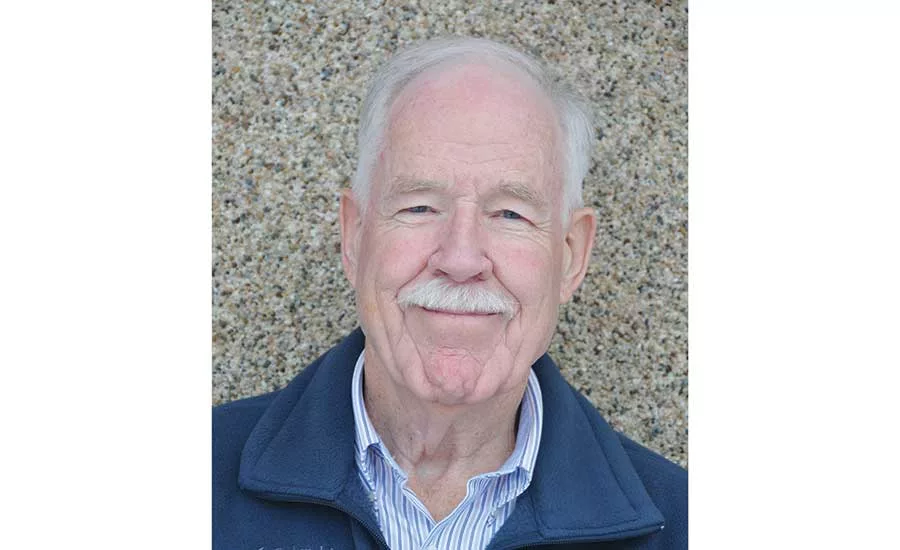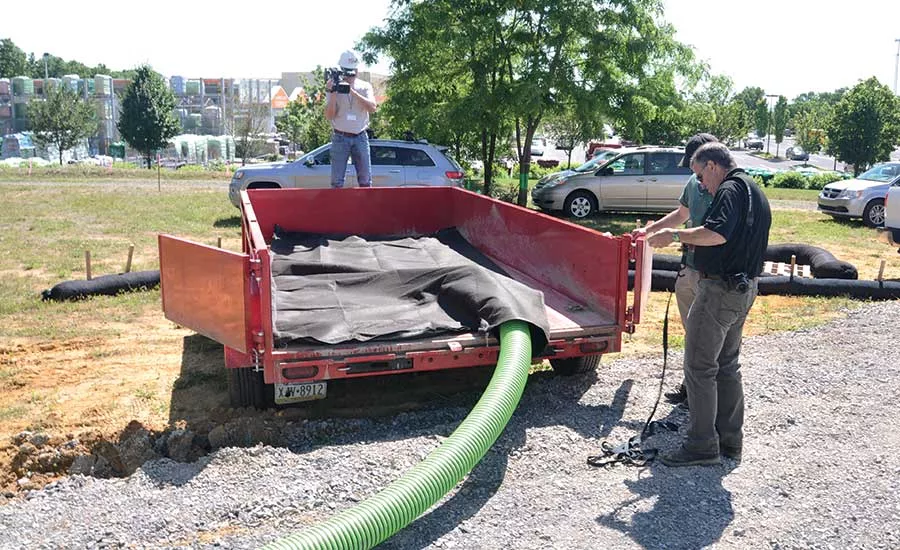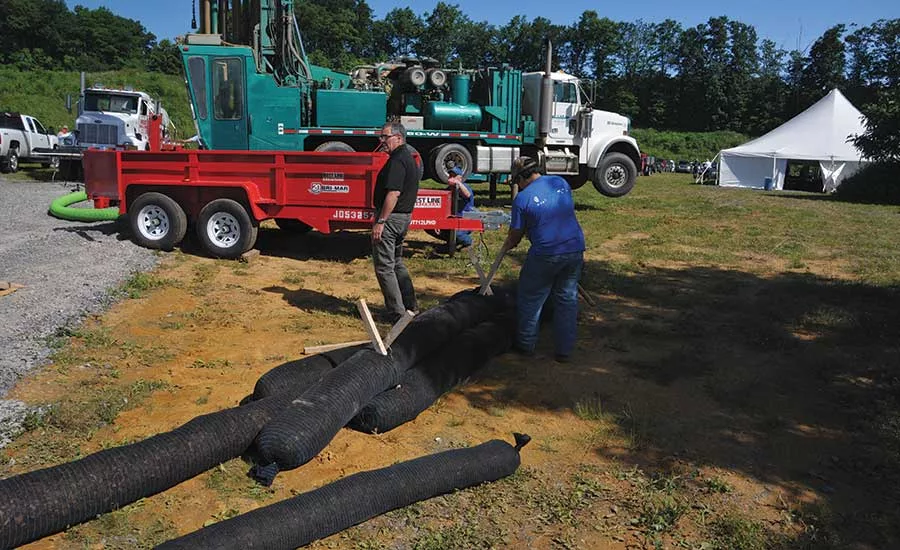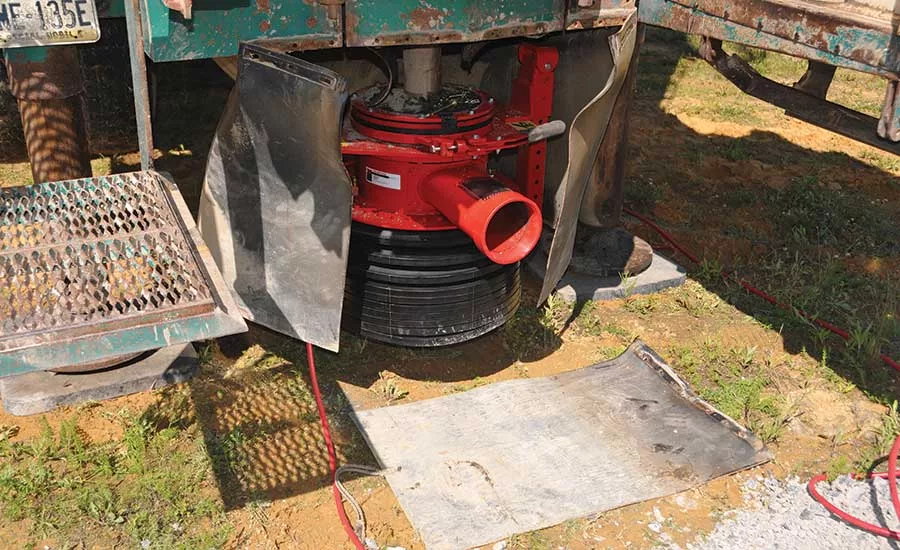Geothermal Drilling Site Cleanup Made Easier


It is recommended that drillers use a 6-inch-diameter hose between the diverter and filter bag so that the pressure from the debris flowing into the bag does not tear it. Source: Todd Giddings and Associates Inc. photos



Geothermal drilling is a messy business. Jobsites get taken over by mud and managing it is an important step to conquer. At the 2017 International Ground Source Heat Pump Association (IGSHPA) conference in Denver, Todd Giddings, Ph.D., PG, presented “Treating Muddy Geothermal Borehole Drilling Water and Contain the Cuttings by Using a Sediment Filter Bag as a Best Management Practice.”
The president of Todd Giddings and Associates Inc., based in Pennsylvania, has spent the past 45 years as a consultant. He uses his subsurface expertise to advise water well and geothermal drillers nationwide. Giddings enjoys solving real-world problems, so after learning about the sediment filter bag, he made it a point to educate geothermal drillers in particular about its usefulness, especially on sites where water and cuttings might flow into a stream or storm drain pipe. In a recent interview with National Driller, Giddings talked about what a sediment filter bag is, how to use it and when to use it.
This interview has been edited for space and clarity.
Q. What is a filter bag and how does it tie into drilling?
A. A filter bag is a bag made of geotech-style fabric. What this fabric is is it is not woven like the cloth in a shirt. It’s a bunch of strands fused together, much like the felt material in a felt hat. The usual size is 6½ feet-by-15 feet. It’s sewn together on an industrial-strength sewing machine. Just two layers of this geotech-style fabric are sewn together to make the bag. On one corner there’s a spout about 1 foot long where a hose can be inserted into the bag and then the bag held onto the end of the hose with a binder strap.
The whole purpose of the bag is to receive, through the hose, the air and water and rock chips and sand and silt and clay coming out of a hole during drilling. The way you make all those rock chips and sand and silt and clay and water and air go through the hose is you fasten a device called a diverter under the drill table of the drill rig. It has rubber bellows on the bottom of the diverter that you inflate with compressed air from the rig and the bellows part extends to the ground, making a seal under pressure.
So the cuttings are coming up through the well casing around the drill stem, the drill rod and being contained within the diverter, and they turn 90 degrees and come out a pipe on the side of the diverter that has a hose attached to it. The 6-inch hose then runs perhaps 20 feet to the sediment filter bag.
Q. How new is the filter bag and how popular is it within the drilling community?
A. It has existed for more than 15 years because it is widely used in the construction industry. When, for example, they’re going to build a new bridge across a stream, they need to dig right to the edge of the stream in order to pour the concrete footers that the bridge will be supported by. They’re right on the edge of the stream, so they’re creating a lot of muddy water. They pump it out of that excavation through sediment filter bags. So they’ve been used in treating muddy construction water for decades, meaning 20 years at least.
The drilling industry has adopted sediment filter bags to contain all the drill cuttings and filter the muddy water for at least 15 years, but it was not widespread 15 years ago. I’ve presented at national groundwater conferences and learned from students that it’s being used at locations across the U.S. There are local vendors manufacturing these geotech-style fabric bags in many states. So they are readily available and are shipped as freight in a box.
Q. In what scenarios is the filter bag most useful?
A. The use of a sediment filter bag is limited to air rotary drilling. It is not a method that can be used with mud rotary drilling. That’s the first major limitation. It is absolutely the most useful where site cleanup is required. To give you an example, where site cleaning often is not required is the drilling of a water well for a new house. The entire lot is not landscaped yet; it’s raw earth. The landscapers will cover up and clean up and do the necessary landscaping, so often the driller can drill the house water well and have no cleanup requirement. So there is no use there for a sediment filter bag.
The absolute most useful location for a sediment filter bag is the scene where the driller is drilling boreholes for the geothermal heat exchanger in a landscaped part of the yard of a house and the owners want their lawn restored. Using a diverter with a hose and a sediment filter bag there is the absolute most effective method compared to having the cuttings and muddy water and silt and clay cover a large area of the yard. You don’t want it to run into the yard next door and put all the mud, silt and clay on the neighbor’s patio.
Q. Explain the process of utilizing a filter bag. Is it always the same?
A. There are different ways and an alternative that does not use the diverter piece of equipment is, near the back of the drill rig you dig a pit in the ground, perhaps 2 or 3 or 4 cubic feet in volume. So the air escapes into the air and the muddy drilling water all runs into the pit. Then you use a pump that has its suction off the bottom of the pit to let all the drill cuttings collect in the water in the pit. Then, at some distance off the bottom, you pump the silt- and clay-containing water into the bag. But, again, it’s particularly in the case of drilling geothermal boreholes in a landscaped yard. The bag and the diverter, together with the hose connecting them, has a cleanup advantage in that you don’t have a big hole in the yard that you have to fill in later and restore the grass over the top of where the hole was.
The other difficulty with pumping from a pit method into the bag is containing all the water to get it to flow into the pit. ... So the investment in the diverter is often an investment drillers will make to give them complete containment of all the cuttings. Because the geotech-style fabric in the bag lets the air pass through it, all it does is inflate like a balloon. I’ve seen 1,200 feet of cubic feet a minute of air easily escape through the bag because that non-woven fabric doesn’t provide much of a restriction to the airflow. What it does contain is most of the silt and a little bit of the clay sized particles.
I want to stress that the water coming out of the bag is definitely not clear water because the fabric has holes in it that let clay and silt particles pass through. So there are locations that require less clay and silt in the water before it runs across the property, for example, into a pristine trout stream. So you can add another best management practice called a compost filter sock. That’s one of those geotech-style wrapped tubes from 5 inches to more than 1 foot in diameter. The composted, natural, woody material inside those tubes actually attracts the silt and clay particles, and holds them. Therefore, the water is considerably clearer, meaning it has less silt and clay in it after it goes through the second treatment system.
Q. What are the alternatives to using a filter bag?
A. More common alternatives are a silt fence to control the muddy drilling water running across the surface, straw bales staked into the ground with wooden stakes in a row to try to contain and stop the sediment and muddy water from running off. Both of those sediment and erosion control methods of straw bales or silt fences can have leaks and blowouts and not completely contain the water. They take considerable time, in the case of the silt fence, to install and bury … it in the ground so water can’t get under it and escape. Water can get under the straw bales and go through the space between the bales.
So those standard methods are very much less effective than a sediment filter bag and require considerable drill site cleanup after the drilling is completed. … When the water’s, at the end of drilling, drained out of the sediment in the filter bag, it’s completely clean material and the filter bag and the sediment in it, being clean fill, can be buried. So there’s not a special requirement for a disposal site. So the containment the filter bag offers makes cleanup much more effective and less expensive, particularly when the drilling, for example, is in the landscaped front yard of a house that is having a geothermal heat pump system installed in it.
Q. What advantages and disadvantages are associated with the use of a filter bag?
A. The diverter is an expensive piece of equipment, meaning not hundreds of dollars, but thousands of dollars. So it’s a significant investment by a driller and yet it offers such complete containment of the muddy water and the cuttings and the air, and puts everything in the bag through the 6-inch hose that it can be — when the driller has several geothermal heat exchanger boreholes to drill in landscaped yards where cleanup is important — a very good investment. It has a long, useful life. The cost is the disadvantage.
The bags are one of the least expensive components, ranging in cost from a small bag — they come in multiples of 6½-by-15 feet and even as large as 20 feet square. The small size is generally under $200. So the cost is a disadvantage to add the diverter for complete containment. A less expensive diverter sits on top of the well casing rather than having bellows and fitting under the drill table. The casing top diverter, while less expensive, can’t contain the drill cuttings and water and air while you’re drilling the hole for the casing. So you’re having a mess around the top of the hole to start with. That’s the advantage of having the bellows converter under the drill table. Time savings is another advantage of the filter bag compared to properly installing straw bales and the silt fence.
Q. What significance does hose diameter hold?
A. To explain why it’s highly recommended to use a 6-inch-diameter hose between the diverter and the bag, if the compressor on the drill rig is delivering 800 cubic feet per minute, in that 6-inch hose, the air and the rock chips and the water are moving along at about 46 miles an hour into the bag. If you were instead to use a 4-inch hose from the diverter to the bag, because it’s a smaller area and you’re still forcing 800 cubic feet a minute through that 4-inch hose, the chips are now flying into the bag at 104 miles an hour. What those angular rock chips will do is hit the side of the bag and start tearing it away and abrasively cut a hole in it. So it’s recommended to use a 6-inch diameter hose where the speed of those chips is slower.
In either case — a 4-inch or 6-inch hose — aim the hose into the middle of the bag so the chips aren’t flying out and immediately, at the end of the hose into the bag, hitting the edge of the bag. If you were to use a 46 mile an hour, 6-inch hose, it could still — aiming it right at the edge of the bag — cut away the bag and cause a leak.
Q. Is switching out filter bags a commonly needed step on a jobsite, or is one bag usually enough?
A. Since these sediment filter bags come in various sizes and some manufacturers will make them to a custom size, you can calculate, since you know the diameter of the hole you’re drilling into the bedrock, what the volume of cuttings will be for, say 150 feet of drilling. If you’re using the trailer to make it easy to haul away, then you can estimate the capacity of the bag and know how many you will need for the depth that you’re drilling and the number of boreholes. If you’re using the bag on the ground and not in a truck, if you have a backhoe with a scoop bucket, you pick up the bag once you let the water drain out of it. You could order a larger size bag depending on how you’re going to lift it up and haul it away from the site. It is recommended to know the total estimated footage you’re drilling to and how many boreholes and order a number of bags that relate to that volume of rock chip cuttings, meaning sand and silt and clay.
Q. What do you do with the filter bag in the end? How do you move it and what do you do with the solids?
A. If you are using a sediment filter bag that’s sitting on the ground, it is not effective to try to pick it up with the forks of a forklift because the fabric of the bag can be punctured by the end of the fork on the fork lift, and if you go deep enough under the bag that you don’t puncture it, a full bag of cuttings weights too much for the strength of the fabric. So, some drillers wanting to use it on the ground construct a custom wooden skid that supports the bag just off the ground. They can then pick that up with the fork lift. Other drillers who use the bags have access to a bucket loader with a large bucket that can scoop under the bag to pick it up, to then load it and take it away.
The idea that we’ve demonstrated is to use a large, two-axel hydraulic dump trailer, where you’re filling the bag with the rock chips and cuttings inside the trailer, allowing the water to filter out of the bag and run out the tailgate of the trailer. Then, since it’s a self-contained hydraulic dumping trailer, when you get to a disposal location it’s very easy to dump the bag out of the trailer with the hydraulic dump mechanism that’s built in. You can rent these hydraulic dump trailers that have different sizes of the bed and different weight limits on the axels to match the size of the bag that you are going to be hauling in it.
As far as where you take the bag, since it is clean earth material in the bag, and since the geotech-style fabric is inert — it has no leaching properties or problems — it can be buried. Geotech-style is used in road foundation construction regularly because it is inert in the environment, non-contaminating. You could find a site where earth fill was being dumped to raise the ground up, maybe raise it up to road level, and dump the bags at a location like that where the fill is being asked for by somebody raising the ground level at that site. So it’s not a material that takes any permit to dispose of.
Looking for a reprint of this article?
From high-res PDFs to custom plaques, order your copy today!


